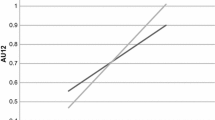Abstract
Previous studies have reported that the expression of smiles is facilitated by social interaction between partners. We examined the effects of social interaction and personal relationships on facial expressions in Japan. Pairs of friends and strangers seated next to each other (the no partition condition) or separated by a partition (the partition condition) were shown film clips aimed to elicit either positive or negative affect. Smiles were facilitated in the no partition condition in which participants interacted with each other. Further, the effect of social interaction on frowns differed depending on whether pairs were friends or strangers.





Similar content being viewed by others
References
Arakawa, A., & Suzuki, N. (2004). Hand movements and feeling. Japanese Journal of Research on Emotions, 10, 56–64.
Bavelas, J. B., Black, A., Lemery, C. R., & Mullett, J. (1986). “I show how you feel”: Motor mimicry as a communicative act. Journal of Personality and Social Psychology, 50, 322–329.
Buck, R. (1984). The communication of emotion. New York: Guilford Press.
Buck, R., Losow, J. I., Murphy, M. M., & Costanzo, P. (1992). Social facilitation and inhibition of emotional expression and communication. Journal of Personality and Social Psychology, 63, 962–968.
Chovil, N. (1991). Social determinants of facial displays. Journal of Nonverbal Behavior, 15, 141–154.
Ekman, P. (1972). Universal and cultural differences in facial expression of emotion. In: J. R. Cole (Ed.), Nebraska symposium on motivation, 1971 (pp. 207–283). Lincoln: University of Nebraska Press.
Ekman, P. (1994). Strong evidence for universals in facial expressions: A reply to Russell’s mistaken critique. Psychological Bulletin, 115, 268–287.
Fernández-Dols, J. M., & Ruiz-Belda, M. A. (1995). Are smiles a sign of happiness? Gold medal winners at the Olympic Games. Journal of Personality and Social Psychology, 69, 1113–1119.
Friesen, W. V. (1972). Cultural differences in facial expressions in a social situation: An experimental test on the concept of display rules. Unpublished doctoral dissertation, University of California, San Francisco.
Fridlund, A. J. (1991). Sociality of solitary smiling: Potentiation by implicit audience. Journal of Personality and Social Psychology, 60, 229–240.
Fridlund, A. J. (1994). Human facial expression: An evolutionary view. San Diego, CA: Academic press.
Friedman, H. S., & Miller-Herringer, T. (1991). Nonverbal display of emotion in public and in private: Self-monitoring, personality, and expressive cues. Journal of Personality and Social Psychology, 61, 766–775.
Hess, U., Banse, R., & Kappas, A. (1995). The intensity of facial expression is determined by underlying affective state and social situation. Journal of Personality and Social Psychology, 69, 280–288.
Jakobs, E., Manstead, A. S. R., & Fischer, A. H. (1999). Social motives, emotional feelings, and smiling. Cognition and Emotion, 13, 321–345.
Jakobs, E., Manstead, A. S. R., & Fischer, A. H. (2001). Social context effect on facial activity in a negative emotional setting. Emotion, 1, 51–69.
Kraut, R. E. (1982). Social presence, facial feedback, and emotion. Journal of Personality and Social Psychology, 42, 853–863.
Kraut, R. E., & Johnston, R. E. (1979). Social and emotional messages of smiling: An ethological approach. Journal of Personality and Social Psychology, 37, 1539–1553.
Lee, V., & Wagner, H. (2002). The effect of social presence on the facial and verbal expression of emotion and the interrelationships among emotion components. Journal of Nonverbal Behabior, 26, 3–25.
Mastumoto, D. (1990). Cultural similarities and differences in display rules. Motivation and Emotion, 14, 195–214.
Matsumoto, D., Yoo, S. H., Hirayama, S., & Petrova, G. (2005). Development and validation of a measure of display rule knowledge: The display rule assessment inventory. Emotion, 5, 23–40.
Ogawa, T., Monchi, R., Kikuya, M., & Suzuki, N. (2000). Development of the General Affect Scales. Japanese Journal of Psychology, 71, 241–246.
Ruiz-Belda, M. A., Fernández-Dols, J. M., Carrera, P., & Barchard, K. (2003). Spontaneous facial expression of happy bowlers and soccer fans. Cognition and Emotion, 17, 315–326.
Wagner, H. L., & Lee, V. (1999). Facial behavior alone and in the presence of others. In: P. Philippot, R. S. Feldman, & E. J. Coats (Eds.), The social context of nonverbal behavior (pp. 262–286). England: Cambridge University Press.
Wagner, H. L., & Smith, J. (1991). Facial expression in the presence of friends and strangers. Journal of Nonverbal Behavior, 15, 201–214.
Yamamoto, K., & Suzuki, N. (2005). The effects of personal relationships on facial displays. Japanese Journal of Psychology, 76, 375–381.
Yarczower, M., & Daruns, L. (1982). Social inhibition of spontaneous facial expressions in children. Journal of Personality and Social Psychology, 43, 831–837.
Acknowledgement
We thank Mr. Junichi Ohnishi, an undergraduate student at Doshisha University, for help in carrying out this research.
Author information
Authors and Affiliations
Corresponding author
Rights and permissions
About this article
Cite this article
Yamamoto, K., Suzuki, N. The Effects of Social Interaction and Personal Relationships on Facial Expressions. J Nonverbal Behav 30, 167–179 (2006). https://doi.org/10.1007/s10919-006-0015-1
Published:
Issue Date:
DOI: https://doi.org/10.1007/s10919-006-0015-1




